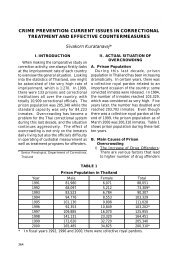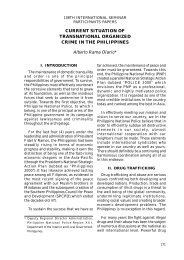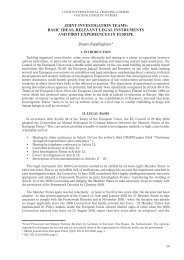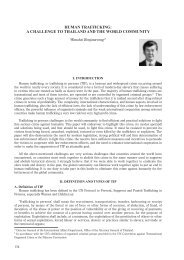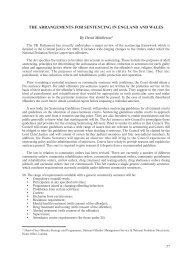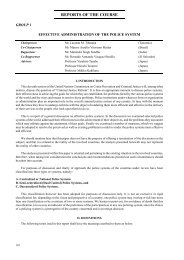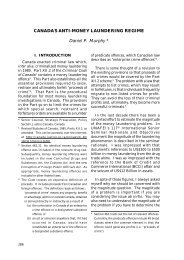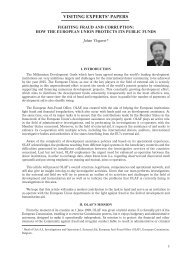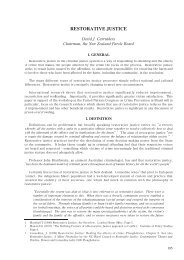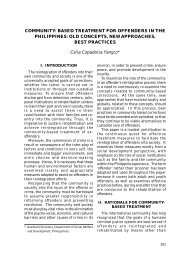LEGISLATIVE MEASURES TO DEAL WITH ECONOMIC CRIMES IN ...
LEGISLATIVE MEASURES TO DEAL WITH ECONOMIC CRIMES IN ...
LEGISLATIVE MEASURES TO DEAL WITH ECONOMIC CRIMES IN ...
Create successful ePaper yourself
Turn your PDF publications into a flip-book with our unique Google optimized e-Paper software.
<strong>LEGISLATIVE</strong> <strong>MEASURES</strong> <strong>TO</strong> <strong>DEAL</strong> <strong>WITH</strong> <strong>ECONOMIC</strong> <strong>CRIMES</strong> <strong>IN</strong> <strong>IN</strong>DIA<br />
Animesh Bharti*<br />
I. <strong>IN</strong>TRODUCTION<br />
Economic Offences form a separate category of criminal offences. Economic Offences not only victimize<br />
individuals with pecuniary loss but can also have serious repercussions on the national economy. Economic<br />
offences, such as counterfeiting of currency, financial scams, fraud, money laundering, etc. are crimes which<br />
evoke serious concern and impact on the Nation’s security and governance. This paper seeks to present a<br />
perspective on the trend of economic crimes and legislative measures to deal with such crimes in India. The<br />
paper is divided into four sections. The first section gives an overview of economic crimes and relevant<br />
legislation and the enforcing agency in India. The second section deals with economic crimes covered under<br />
the Indian Penal Code. The third section explains the law on money laundering and the fourth section<br />
focuses upon cyber crimes, which is expanding rapidly with the growing use of the Internet.<br />
II. <strong>ECONOMIC</strong> <strong>CRIMES</strong>: AN OVERVIEW<br />
A table listing various economic offences, the relevant legislation and the enforcing authorities in India is<br />
given below:<br />
Sl. No.<br />
1.<br />
2.<br />
3.<br />
4.<br />
5.<br />
6.<br />
7.<br />
8.<br />
9.<br />
10.<br />
11.<br />
12.<br />
13.<br />
14.<br />
15.<br />
16.<br />
* Deputy Secretary (Crime Monitoring), Ministry of Home Affairs, Government of India.<br />
1 Central Bureau of Investigation.<br />
2 Narcotics Control Bureau.<br />
Economic Economic Crimes<br />
Tax Evasion<br />
Illicit Trafficking in Contraband<br />
Goods (Smuggling)<br />
Evasion of Excise Duty<br />
Cultural Object’s Theft<br />
Money Laundering<br />
Foreign Contribution<br />
Manipulations<br />
Land Hijacking/Real Estate Fraud<br />
Trade in Human Body parts<br />
Illicit Drug Trafficking<br />
Fraudulent Bankruptcy<br />
Corruption and Bribery of Public<br />
Servants<br />
Bank Fraud<br />
Insurance Fraud<br />
Racketeering in Employment<br />
Illegal Foreign Trade<br />
Racketeering in False Travel<br />
Documents<br />
Acts of Legislation<br />
Income Tax Act<br />
Customs Act 1962<br />
COFEPOSA, 1974<br />
Central Excise and Salt Act, 1944<br />
Antiquity and Art Treasures Act,<br />
1972<br />
Foreign Exchange Regulations Act,<br />
1973<br />
Foreign Contribution (Regulation)<br />
Act, 1976<br />
IPC<br />
Transplantation of Human Organs<br />
Narcotics Drugs and Psychotropic<br />
Substances Act 1985 & NDPS Act,<br />
1988<br />
Banking Regulation Act, 1949<br />
Prevention of Corruption Act, 1988<br />
IPC<br />
IPC<br />
IPC<br />
Import & Export (Control) Act,<br />
1947<br />
Passport Act, 1920/IPC<br />
Enforcement Authorities<br />
Central Board of Direct Taxes<br />
Collectors of Customs<br />
Collectors of Central Excise<br />
Police/CBI 1<br />
Directorate of Enforcement<br />
Police/CBI<br />
Police/CBI<br />
Police/CBI<br />
NCB 2 /Police/CBI<br />
CBI<br />
State/Anti Corruption<br />
Bureaux/Vigilance Bureaux/CBI<br />
Police/CBI<br />
Police/CBI<br />
Police/CBI<br />
Directorate General of Foreign<br />
Trade/CBI<br />
Police/CBI<br />
209
17.<br />
18.<br />
19.<br />
20.<br />
21.<br />
22.<br />
23.<br />
24.<br />
210<br />
Credit Card Fraud<br />
Terrorists Activities<br />
Illicit Trafficking in Arms<br />
Illicit Trafficking in Explosives<br />
Theft of Intellectual Property<br />
Computer Crime/Software Piracy/<br />
Cyber Law<br />
Stock Market Manipulations<br />
Company Fraud (Contraband)<br />
RESOURCE MATERIAL SERIES No.67<br />
III. <strong>ECONOMIC</strong> <strong>CRIMES</strong> UNDER THE <strong>IN</strong>DIAN PENAL CODE (IPC)<br />
The Indian Penal Code contains provisions to check economic crimes such as Bank Fraud, Insurance<br />
fraud, Credit card fraud, stock market manipulation, etc. The local police deal with the IPC crimes falling<br />
under the broad categories of ‘Cheating’ (Section 415-424), ‘Counterfeiting’ (Coins & Stamps Section 230-<br />
263A and Currency Section 489A-489E) and ‘Criminal Breach of Trust’ (Section 405-409).<br />
A. Serious/Major Fraud<br />
Statistics on the serious/major frauds reported and registered under the Criminal Breach of Trust (CBT)<br />
cases and cheating cases for the years 2000-2002 is given in the table below.<br />
Major Frauds Reported During 2000-2002<br />
Sl.<br />
No.<br />
1.<br />
2.<br />
3.<br />
4.<br />
5.<br />
Value of Property<br />
lost/defrauded<br />
(in Rs. Crore)<br />
1-10<br />
20-25<br />
25-50<br />
50-100<br />
Above 100<br />
Total<br />
CBT<br />
430<br />
2<br />
0<br />
0<br />
1<br />
433<br />
IPC<br />
POTA-2002<br />
Arms Act, 1959<br />
Explosives Act, 1884 & Explosive<br />
Substance Act, 1908<br />
Copyright Act, 1957<br />
(Amendments 1984 & 1994)<br />
Copyright Act, 1957/I.T. Act 2000<br />
IPC<br />
Companies Act, 1956/IPC MRTP<br />
Act, 1968<br />
Cheating<br />
1192<br />
6<br />
0<br />
1<br />
0<br />
1199<br />
The number of serious fraud cases registered under the Criminal Breach of Trust and Cheating cases was<br />
lower in 2002 as compared to 2001.<br />
IV. MONEY LAUNDER<strong>IN</strong>G<br />
Police/CBI<br />
Police/CBI<br />
Police/CBI<br />
Police/CBI<br />
Police/CBI<br />
Police/CBI<br />
Police/CBI<br />
Police/CBI<br />
2000 2001 2002<br />
Money laundering is the process of cleaning dirty money with the objective of hiding its source and<br />
enabling it to be used later in a legal form. This process creates a web to hide the origin/true nature of these<br />
funds. Prior to the enactment of the Prevention of Money Laundering Act, 2002 this crime was covered<br />
under the violation of foreign exchange rules under the Foreign Exchange Regulation Act (FERA) and later<br />
under the Foreign Exchange Management Act (FEMA).<br />
Statistics on cases under FERA for the year 1998-2002 are given below.<br />
CBT<br />
246<br />
1<br />
0<br />
0<br />
1<br />
248<br />
Cheating<br />
2246<br />
3<br />
3<br />
1<br />
0<br />
2253<br />
CBT<br />
117<br />
4<br />
2<br />
2<br />
3<br />
128<br />
Cheating<br />
550<br />
10<br />
2<br />
1<br />
2<br />
565
128TH <strong>IN</strong>TERNATIONAL TRA<strong>IN</strong><strong>IN</strong>G COURSE<br />
PARTICIPANTS’ PAPERS<br />
Money Laundering (1998-2002) (Cases under FERA)<br />
Sl.<br />
No.<br />
1.<br />
2.<br />
3.<br />
4.<br />
5.<br />
Year No. of Currency Seized<br />
(In Indian Rs. in crore)<br />
Searches/ Seizures/ Indian Foreign<br />
Raids Recoveries<br />
1998 544 361 7.1 2.3<br />
1999 387 299 4.9 0.8<br />
2000 330 262 3.6 2.2<br />
2001 295 207 1.2 2.7<br />
2002 417 303 0.8 1.2<br />
In 2002, 417 searches/raids were conducted in money laundering cases as against 295 in 2001. Though<br />
there has been a declining trend in the number of seizures/recoveries during 1998 to 2001, an increase was<br />
observed in 2002.<br />
In 2002, the recoveries, seizures made under FERA violations, yielded Rs. 0.8 crore of Indian currency<br />
and Rs.1.2 crore Indian equivalent of foreign currency. The value of confiscated currencies i.e. both Indian<br />
and foreign had decreased over the previous year.<br />
A. Prevention of Money Laundering Act, 2002<br />
The Prevention of Money Laundering Act (PML), 2002 was passed by the Parliament of India in<br />
December 2003. This Act is applicable to all States/Union Territories of India including Jammu & Kashmir<br />
and overrides the provisions of any other statue in force. The Legislation is effective from the date the Rules<br />
under the PML Act are prescribed.<br />
The PML Act seeks to combat money laundering in India and has three main objectives:<br />
• To prevent, combat and control money laundering<br />
Currency confiscated<br />
(In Indian Rs. in crore)<br />
Indian Foreign<br />
• To confiscate and seize the property obtained from the laundered money; and<br />
• To deal with any other issue connected with money laundering in India.<br />
In brief, the important provisions of the PML Act are as follows:<br />
• Any person, who directly/indirectly indulges in any activity/process connected with the proceeds of<br />
crime and projects it as untainted property, shall be guilty of money laundering.<br />
• The term ‘ proceeds of crime’ means any property that has been derived, directly/indirectly by a<br />
person from a criminal activity relating to a scheduled offence in the Act.<br />
• There is a Schedule annexed to the Act which carries a list of the offences, the proceeds derived<br />
from the commission of which can be treated as the proceeds of crime. This list is exhaustive in<br />
nature and any property derived from an offence other than these activities cannot be brought under<br />
this Statute.<br />
The Schedule includes offences under:<br />
- The Indian Penal Code<br />
- The Narcotic Drugs and Psychotropic Substances Act, 1985<br />
- The Arms Act, 1959<br />
- The Wild Life (Protection) Act, 1972<br />
- The Immoral Traffic (Prevention) Act, 1956<br />
- The Prevention of Corruption Act, 1988<br />
• The term ‘proceeds of crime’ is intrinsically linked with the term ‘property’ since any conversion of<br />
the original proceeds that is in monetary form will result in the creation of an asset. Any person who<br />
indulges in a criminal activity listed in Para 2.3.3 above shall be liable under the Act and the asset<br />
4.6<br />
4.2<br />
5.7<br />
2.7<br />
1.0<br />
1.8<br />
5.8<br />
4.8<br />
4.2<br />
4.0<br />
Fines<br />
(in Indian Rs. in Crore)<br />
Imposed Realised<br />
170.2<br />
194.3<br />
318.4<br />
491.1<br />
354.4<br />
1.8<br />
46.7<br />
3.0<br />
3.5<br />
3.4<br />
211
212<br />
RESOURCE MATERIAL SERIES No.67<br />
derived from this activity shall be treated as the proceeds of crime. All assets of any nature and any<br />
description will fall within the ambit of the terms ‘property’.<br />
• The minimum penalty for committing an offence under the Act is rigorous imprisonment for three<br />
years along with a fine that may extend to Rs.5 lakh. The maximum imprisonment is 7 years for<br />
general offences. However, if the person is convicted of a specific offence under the NDPS Act, he<br />
may be imprisoned for a period of 10 years.<br />
• Filling of a criminal complaint is a pre-requisite to the initiation of civil proceedings. Thereafter, the<br />
special court will take the complaint into cognizance. If the person is acquitted by the special court,<br />
all civil proceeding shall stand vacated.<br />
• Further, the activity of laundering money is a separate crime from the activity from which the money<br />
was sourced. For, instance, drug peddling would be a separate crime from the crime of laundering its<br />
proceeds.<br />
• The Act provides for provisional attachment/seizure of any property if the adjudicating authority has<br />
reason to believe that the said property is involved in money laundering. The property is confiscated<br />
when the attachment gets confirmed after conviction of the accused and such property vests in the<br />
Central Government.<br />
• The Act prescribes various mandatory procedures to be followed by the banking institutions for<br />
maintaining records of all transactions and informing of such transactions within a prescribed time<br />
limit. Obligation has also been cast on these institutions to verify and maintain the record of the<br />
identity of its clients. These records must be maintained for a period of 10 years.<br />
• When any authority has any reason to believe that any person is in possession of or has acquired any<br />
property from a criminal activity under the Act, he has the power to make enquiries/conduct<br />
surveys/searches.<br />
• The authorities designated under this Act are authorized to arrest a person if they have reasons to<br />
believe that he has committed an act, which constitutes the offence of money laundering under this<br />
Act.<br />
• Any person who is aggrieved by the order of the adjudicating authority has the right to appeal before<br />
the Appellate Tribunal.<br />
• Special Courts shall be set up by the Central Government to conduct the trial of the offences of<br />
money laundering. The authorities under the Act like the Director, Adjudicating Authority and the<br />
Appellate Tribunal have been constituted to carry out the proceedings related to attachment and<br />
confiscation of any property derived from money laundering.<br />
• In order to enlarge the scope of this Act and to achieve the desired objectives, the Act provides for<br />
bilateral agreements between countries to cooperate with each other and curb the menace of money<br />
laundering. These agreements are for the purpose of either enforcing the provisions of this Act or<br />
the exchange of information that will help in the prevention of the commission of an offence under<br />
this Act or the corresponding laws in that foreign state.<br />
• In certain cases the Central Government may seek/provide assistance from/to a contracting State for<br />
any investigation or forwarding of evidence collected during the course of such investigation.<br />
• The Act provides for reciprocal arrangements for processes/assistance with regard to accused<br />
persons.
128TH <strong>IN</strong>TERNATIONAL TRA<strong>IN</strong><strong>IN</strong>G COURSE<br />
PARTICIPANTS’ PAPERS<br />
B. Steps Taken by the Government to Curb Money Laundering<br />
• Several steps have been taken by the Government of India to tackle the problem of money<br />
laundering effectively. The Reserve Bank of India, which is the Central Bank for the country, has<br />
issued directions to be strictly followed by the Banks regarding the standard practices under the<br />
‘Know Your Customer’ (KYC) guidelines. The banks are required to obtain all information necessary<br />
to establish the identity/legal existence of each new customer. These guidelines are to be<br />
scrupulously followed by the overseas branches of Indian banks also.<br />
• The PMLA makes it mandatory for every banking company, financial institution and intermediary to<br />
maintain records of transactions for a period of ten years. In case of any violation of this legal<br />
obligation, these institutions have to face penal consequences.<br />
• The PMLA also provides for reciprocal arrangements between India and other countries for<br />
enforcing the provisions of this Act and for exchange of information for prevention of any offence<br />
under this Act or under the corresponding law in force in that country for investigation of cases<br />
relating to any offence under this Act.<br />
V. <strong>MEASURES</strong> <strong>TO</strong> COMBAT COMPUTER RELATED <strong>CRIMES</strong><br />
Information Technology has reduced the world into a small village with no respect for geographical<br />
boundaries. The advent of information technology has not only introduced new forms of crimes but new<br />
variants of already existing criminal action as well. During the last decade, India has faced a new challenge<br />
tackling a new and sophisticated form of crime in the form of cyber crime.<br />
The most common forms of computer crimes reported are:<br />
• Intrusions/Hacking in computer networks for the purpose of defacing a web site, theft of password to<br />
gain an unauthorized access, theft of personal information like credit card numbers, etc.<br />
• Espionage<br />
• Frauds/cheating<br />
Cases registered in this category of crimes in the year 2002 are given below:<br />
Cyber Crimes/Cases Registered and Persons Arrested Under IT Act, 2000<br />
Sl. No<br />
1.<br />
2.<br />
3.<br />
4.<br />
5.<br />
6.<br />
Description<br />
Tampering with Source Documents<br />
Hacking of Computer Systems<br />
i) Loss/Damage to Computer Resource/Utility<br />
ii) Hacking<br />
Obscene Publication/Transmission in Electronic Form<br />
Digital Signature Fraud<br />
Breach of Confidentiality/Privacy<br />
Others<br />
Total<br />
Cases Registered<br />
6<br />
Persons Arrested<br />
2<br />
Of the 70 cases registered under the IT Act 2000, around 47 percent of cases pertain to obscene<br />
publication/transmission in electronic form, normally known as cases of cyber pornography. Thirty-eight<br />
persons were taken into custody for such offences during 2002. There were 26 cases of Hacking of computer<br />
systems wherein 21 persons were arrested in 2002. Of the total (26) Hacking cases, the cases relating to<br />
Loss/Damage to computer resource/utility under Sec 66(1) of the IT Act were to the tune of 58 percent and<br />
that related to Hacking under Section 66(2) of the IT Act were 42 percent (11 cases).<br />
15<br />
11<br />
33<br />
1<br />
3<br />
1<br />
70<br />
9<br />
12<br />
38<br />
-<br />
-<br />
4<br />
65<br />
213
RESOURCE MATERIAL SERIES No.67<br />
Cyber Crimes/Cases Registered and Persons Arrested Under IPC During 2002<br />
Sl. No<br />
Of the 738 cases registered for Cyber Crimes under IPC, the majority of the crimes fall under 3<br />
categories viz. Criminal Breach of Trust or Fraud (510), Forgery (167) and Counterfeiting (59). Though<br />
these offences fall under the traditional IPC crimes, the cases had cyber undertones wherein computers, the<br />
Internet or its related aspects were present in the crime and hence they were categorized as Cyber Crimes<br />
under IPC. Interestingly, the number of cases under Cyber Crimes relating to Counterfeiting of<br />
currency/stamps stood at 49 wherein 124 persons were arrested during 2002. Of the 46,271 cases reported<br />
under cheating, Cyber Forgery (167) accounted for 0.4 percent. Of the total Criminal Breach of Trust cases<br />
(14,027), the Cyber Frauds (510) accounted for 3.6 percent while under the Counterfeiting offences (1522),<br />
Cyber Counterfeiting (59 out of 1522) offences accounted for 3.9 percent.<br />
In order to tackle the acrimonious relationship between the law and crime caused by information<br />
technology, the Government of India has adopted some of the provisions of the Model Law on Electronic<br />
Commerce by the United Nations Commission on International Trade Law (UNCITRAL) and enacted the<br />
Information Technology Act, 2000. This Act has been enacted for according legal recognition to the<br />
authentication of information exchanged in respect of commercial transactions conducted by means of<br />
Electronic Communications Technology. The main focus of this Act is on the following areas:<br />
214<br />
1.<br />
2.<br />
3.<br />
4.<br />
5.<br />
Description<br />
Fake Electronic Evidence<br />
Destruction of Electronic Evidence<br />
Forgery<br />
Criminal Breach of Trust/Fraud<br />
Counterfeiting<br />
i) Property Mark<br />
ii) Tampering<br />
iii) Currency/Stamps<br />
Total<br />
Cases Registered<br />
2<br />
0<br />
167<br />
510<br />
Persons Arrested<br />
6<br />
1<br />
357<br />
785<br />
0<br />
37<br />
124<br />
1310<br />
I. Legal recognition of:<br />
(a) Digital signatures, which include<br />
- Acceptance in lieu of hand written signatures<br />
- Authentication<br />
- Security<br />
(b) Electronic Records, which includes<br />
- Retention<br />
- Attribution, Acknowledgment and Dispatch<br />
- Security<br />
• Creation of an infrastructure for issuance and regulation of digital signature certificates.<br />
• Creation of a cyber regulations appellate tribunal.<br />
• Amendments in existing laws to give recognition to electronic documents.<br />
• Offences and penalties for cyber crimes.<br />
• This Act defines two kinds of liabilities, civil and criminal, for various cyber crimes. The Civil<br />
liabilities are in the form of penalties for example:<br />
Section 43 & 44 of this Act prescribes the penalty for the following offences:<br />
• Unauthorised copying of an extract from any data/database.<br />
• Unauthorised access and downloading of files.<br />
• Introduction of viruses/malicious programmes.<br />
• Damage to a computer system and computer network.<br />
• Denial of access to an authorised person to a computer system.<br />
• Providing assistance to any person to facilitate unauthorised access to a computer.<br />
• Charging the service availed by a person to an account of another person by tampering and<br />
manipulation of a computer/computer system.<br />
0<br />
10<br />
49<br />
738
128TH <strong>IN</strong>TERNATIONAL TRA<strong>IN</strong><strong>IN</strong>G COURSE<br />
PARTICIPANTS’ PAPERS<br />
The criminal liabilities are dealt with in a separate chapter under ‘offences’. Section 65 to 75 of this Act<br />
provide for different forms of imprisonment according to the offence, so far as criminal liabilities are<br />
concerned. They cover:<br />
• Tempering with computer source documents.<br />
• Hacking of computer systems.<br />
• Electronic forgery i.e. preparing of false electronic records, affixing of false digital signatures, etc.<br />
• Electronic forgery for the purpose of cheating.<br />
• Electronic forgery for the purpose of harming reputation.<br />
• Using as genuine a forged electronic record.<br />
• Publication of digital signature certificate for a fraudulent purpose.<br />
• Unauthorised access to protected systems.<br />
• Publication of information in an electronic form, which is obscene in nature.<br />
With the amendment of the definition of document by providing authenticity to electronic documents in<br />
the existing Indian Penal Code, Indian Evidence Act, Bankers Book of Evidence, etc. the Act has also<br />
facilitated use of the existing criminal laws for tackling the conventional crimes committed using computer<br />
technology like forgery of documents, cheating, impersonation, stalking, theft, etc.<br />
Actions Proposed at the International Level are as Follows<br />
(1) Uniform international model laws may be developed for defining the various facets of crimes<br />
committed in a computerized environment.<br />
(2) The international law for cooperation between different countries may be standardized in order to<br />
enhance the possibilities of tackling trans-national crimes with provisions for a faster mode of<br />
cooperation of the existing procedure related to letters of request.<br />
(3) The interaction between the law enforcement agencies of different countries at formal and informal<br />
levels should be increased in order to increase the flow of information related to the crimes<br />
committed and technology developed for anticipating, tackling and enforcement of the law.<br />
215




